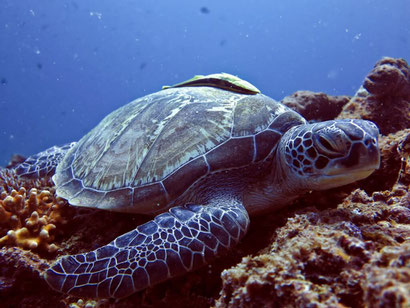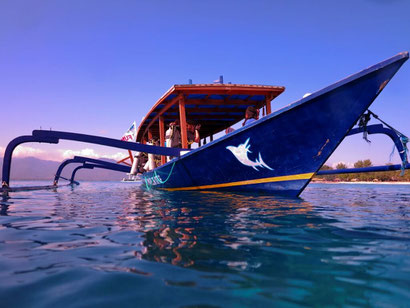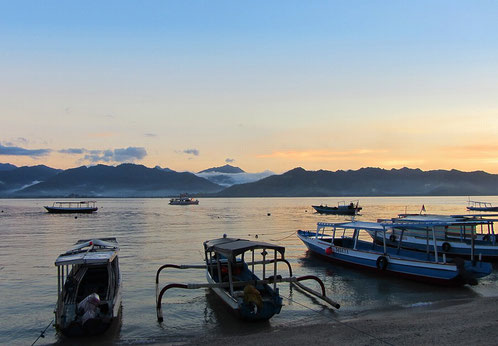This is one of ten fun stories from ten years of travelling - the rest are here.
When people think of Indonesia, they usually think of Bali yet, that emerald island is one of over 17,000 that make up the world’s largest archipelago.
You’ll often hear travellers say ‘oh I’ve done Indonesia’, and when you question them further they’ve visited just the one (largely Hindu) isle.
There is a crazy amount to do of course, and unlike the rest of Indonesia, Bali’s predominantly Hindu culture is a striking contrast to the rest of the conservative Muslim nation, so it’s a little more relaxed when it comes to drinking and having a good time.
If you decide to venture to one of the other islands, then just 2.5 hours by fast boat and you arrive at three of Indonesia’s gems – The Gili Islands.

These tiny islands lie just off the coast of Lombok, a pretty, if underdeveloped place that isn’t the easiest to travel around without a tour or a lot of time.
The three islands always reminded me a little of the tale of porridge in Goldilocks. Gili Trawangan is the largest of the three, though you can still walk all the way around it in less than two hours. This is a busy island, well developed with a huge range of hotels, from budget right up to fancy places with their own helipad (I’m not kidding).
Trawangan is a party island, and for me, it’s the bowl of porridge that’s just too big. At the other end of the scale, you have Gili Meno, a super tiny island you can walk around in about 45 minutes. This place is underdeveloped, quiet and great if you want a touch of serenity. You might have guessed by now that for me, this island is just too small.
That leaves Gili Air, the mid-sized offering, one that you can walk around in under an hour, as the perfect choice for us.
Not long after we had qualified as diving instructors, a process that took months of training as part of an internship in Mexico, we found ourselves working on Borneo. A wonderful resort over the sea that sadly had no customers. Not ideal. We were given free food and board, but with no customers, we didn’t earn anything.

Alex gets very bored very quickly, if he’s not super busy, he’s not super happy. This meant that when we were offered a job managing our own dive shop, we jumped at the chance. So what if we’d only been diving instructors for a couple of months, how hard could running your own shop be?
To get from Malaysian Borneo over to Gill Air turns out to be a pretty massive endeavour. Borneo is one of the world’s top five largest islands and is owned by three different countries.
We had to get from Malaysian Borneo over into Indonesian Borneo, a process that involved getting a bus to a border town, and then a ferry that takes you from one scary port in Malaysia to a super scary port in Indonesia. This is a trip that’s not advised for westerners because, if you believe the UK Government website, certain death at the hands of pirates is sure to befall you.
We didn’t die that time, which was handy, as we then had to catch a plane over to Java, the large island to the east of Bali, get a bus to Bali, then the fast boat over to Gili Trawangan. We arrived at our new bosses dive shop late at night and dazed from the journey.
They appeared nice people (they turned out to be evil incarnate, but we didn’t find this out until many weeks later).
They ran a successful dive shop on the big island, and they wanted to replicate something similar on Gili Air. This all sounded fun for us, we’ve always been ‘get on with it’ kinda guys, so we were looking forward to the challenge.
When you take a job as a diving instructor, one of the first things you have to do is learn the dive sites. Most shops will have several that they visit regularly and you have to learn these as soon as possible. To be a decent dive guide takes a lot of trips to a site where you’ll learn where certain creatures hide, or where you’re most likely to see a turtle or a shark, etc., but you have to start somewhere.
Over the next week, we did countless dives getting to know the best sites. We’d arrived in a good season where the water was clear (sometimes 30 metres visibility), so it was easy to be shown the sites. The process generally was that we tagged along at the back of an instructor who was taking out students.

And then came our visit to a site called Deep Turbo. The Gili’s are known for their strong currents that sweep down the islands and most of the dives are drift dives. A drift dive occurs when you position yourself in the current and let it take you along. You go in at one spot, and the boat collects you at another.
Deep Turbo is known for its exceptional currents, which does beg the question, why go there? Well, the thing with currents is that it brings in the small creatures, which in turn brings in the larger beasties and it’s these, sharks and the like, that people want to see.
There are a couple of sites around the Gilis that require deeper dives, down to 30m (98ft), but most of them are pretty shallow maxing out around 20m (66ft).
Deep Turbo is a site that goes down for what seems like forever. At this site, the bottom is much deeper than any recreational diver would usually go to, but it has some underwater pinnacles that pop up, and you can swim around.
The day we went to survey this site the water had poor visibility. The instructor leading the dive had her hands full with her divers, and she told us that if we get split up to finish our dive on our own and meet back at the boat. Now, all diving instructors have to carry a bright coloured float on a string that you send to the surface at the end of the dive. This is something that the boat can spot, and it makes it easier for them to find you. (for those who enjoy a pointless detail, this thing is called an SMB)
The boat crew generally have a rough idea how far you will have travelled with the currents, so they aren’t usually that far away.

The current raged as we descended into the dark waters. The sky overhead held thick grey clouds, and the promise of a tropical downpour helped darken the water further.
At 10m (30ft) we lost site of the instructor and could only make out the fins of the final diver as they disappeared into the gloom. Once out of site, Alex and I looked at each other, took in the bleak conditions and were about to abort the dive when our dive computers started beeping.
We were now at 20m and still descending. A strong down current pulled us into the blackening depths. Seconds later and we hit 30m – at this depth, there is a risk of a condition called nitrogen narcosis. This is a fun thing our body does to us as we dive at dePth – it’s rarely fun tbh.
Even for the same person, this condition doesn’t always happen, and when it does, the results can be different every time.
Being ‘narc’d’ can affect us in, generally, one of three ways – we can become reckless/experience a feeling of being invincible. I’ve seen experienced instructors trying to take their dive gear off at 30m because they think that’s a great time to fix a leak.
It can make us feel as if we’re drunk, off balance, out of control, but with a big smile on your face.
When we rushed past 30m – Alex’s face clearly had evidence of the 3rd way being nark’d can hit you – that of confusion and panic. Now Alex is an excellent diver, much better than me, and unlike me, he tends not to panic. Knowing this, and the terrified look on his face assured me that he was nark’d.
At 35m our dive computers were going mental. A current now hit us from one side and started pushing us along. I grabbed hold of Alex and started to put air into my jacket. One of the easiest ways to die as a diver is to ascend too quickly, so though I had to stop us going any deeper, we couldn’t dart towards the surface. Alex’s breathing was becoming incredibly erratic, and through his mask, I could see that his eyes were wide skin had lost all colour.
The air slowed our decent, though we continued to be driven along by the current. I later found out that we’d dropped to 45m before we started to move towards the surface. Thankfully, we did start heading up and at a pace that didn’t cause the air bubbles in our blood to expand and kill us.
Once past 30m deep Alex’s face changed, the narcosis passed, and he was back in control. I was all set to head for the surface, but we had been down too long and too deep. Our air was getting low too.
With dive computers still going mental (I think mine actually stopped working in protest), Alex levelled us out at 16m and set his buoy off to the surface (connected to him by a rope).
We then had to sit there while our dive watches counted down. We had just enough air, which means that it was just about safe enough for us to do a decompression stop. We could have headed to the surface, but it would have been at the risk of the Bends (not pretty).
We floated there, in shock, for about 15 minutes. All the time being pushed along by a strong current. A current that had two ways to take us, towards land, or out to sea.
Hands up who knows which way it took us? That’s right, out to sea.
When we eventually made it to the surface, there was no land in sight. Nothing, just sea, dark skies and a ‘great, we’re going to die’ feeling welling in our stomachs. (This has happened far too many times on our travels).
We bobbed around for what seemed like forever, though I believe in reality it was all of ten minutes. Around the Gilis is a busy part of the world boating wise, and much to our delights a dive boat belonging to Diversia Divers appeared in the distance.
We waved, and then took a fin off each and waved that (top tip for you when you’re lost at sea as a diver; wave a fin, it’s bigger).
The crew saw us, laughed a little too much when they pulled up alongside us and told us we owed them a beer for the rescue when we got back to land.
